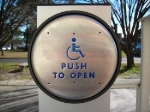
Cerebral palsy affects approximately 800,000 children and adults in the United States. Experts have estimated that 3 in 1,000 infants born may suffer some form of cerebral palsy. However, many people are unaware of the condition and its symptoms. Understanding cerebral palsy is important to providing the best quality of care and true understanding for those who must accommodate this lifelong condition.
Photo by Kevin Jamieson (Free Images) Photo Caption: Open the path to excellent cerebral palsy care.
What is Cerebral Palsy?
Cerebral palsy refers to a number of interrelated neurological disorders that typically appear in early infancy and childhood. Although there are several different forms of the disorder, each one is characterized by permanent symptoms affecting movement and coordination. All forms of cerebral palsy are disorders of the brain’s cerebral cortex, which controls movement.
Causes of Cerebral Palsy
Cerebral palsy can stem from a birth abnormality or can result from trauma suffered before, during, or right after birth. In either case, the brain damage sustained is irreversible and the effect on the patient is permanent. Babies born prematurely are at enhanced risk of cerebral palsy, as are those whose oxygen intake is hindered for any reason during the birthing process.
Types of Cerebral Palsy
There are several different types of cerebral palsy:
- Dyskinetic: Dyskinetic cerebral palsy presents through slow “writhing” or jerking of the extremities, which is involuntary. Children afflicted with dyskinetic cerebral palsy may have difficulty walking, sitting, or breathing and may face complications speaking.
- Ataxic: Ataxic cerebral palsy causes unsteady walking and a wide gait. Sufferers have difficulty with balance, coordination, and depth perception. Fine motor movements such as writing, picking up small objects, and buttoning clothing may be difficult.
- Spastic: Spastic cerebral palsy causes widespread muscle stiffness and difficulty with movement. Spastic cerebral palsy can affect the hand and limbs on one side of the body, or it can express itself in the legs, requiring specialized braces or other assistance.
- Spastic Quadriplegic Cerebral Palsy: This form of cerebral palsy is the most severe, and sufferers may have significant cognitive impairment. Serious stiffness affects the limbs and is accompanied by a lack of muscle tone in the neck. Speaking and walking may be impossible.
Management and Therapy
Children suffering from cerebral palsy should be tested to determine their range of movement, susceptibility to seizures, and prospects for learning. No matter which form of cerebral palsy a person has, the disorder is not progressive – it does not worsen with time. Although brain damage is irreversible, many symptoms can be significantly reduced by appropriate intervention.
There are several forms of therapy that are frequently helpful:
- Occupational Therapy: Occupational therapy helps people who have movement-related impairments, including walking and grasping objects. An occupational therapist will develop small tests, games, and exercises the sufferer can use to build their coordination.
- Speech Therapy: Across different types of cerebral palsy, many sufferers have difficulty articulating words. They may speak with a lisp or have a stutter. Over time, guided practice with a speech therapist can sometimes eliminate speech-related symptoms.
- Mobility Aids: Many sufferers of spastic cerebral palsy may need some form of mobility aid. In some cases, specialized braces can make walking easier. Surgeries might effectively loosen tendons and other parts of the legs that have a tendency to be tight.
- Medication: For cerebral palsy complicated by seizures, anti-seizure medication can be valuable for controlling symptoms. Some sufferers will need to continue treatment with anti-seizure medication for the rest of their lives.
Legal Issues for Individuals With Cerebral Palsy
In many cases, the damage leading to cerebral palsy might be the result of medical malpractice or negligence. For example, a delivery room doctor might mishandle a newborn child, leading to temporary asphyxiation and associated brain damage.
In these cases, it is important to pursue recompense. Even mild forms of cerebral palsy may require a sufferer to be under lifelong care. Collecting on a malpractice claim can be extremely helpful, even if the sufferer qualifies for Social Security or Medicaid.
Many legal issues surrounding cerebral palsy have to do with the extent to which a sufferer who is developmentally delayed might be able to achieve independence. Even those who suffer from significant cerebral palsy complications may be able to work and develop relationships.
Those with mild cerebral palsy face legal challenges in qualifying for disability aid. Although cerebral palsy lasts for life, sufferers whose symptoms are not considered obvious may encounter discrimination when making claims for aid. Help from a lawyer may be necessary.
Resources
- Cerebral Palsy Information and Types
- Details on Cerebral Palsy
- Understanding Cerebral Palsy
- Cerebral Palsy Topics
- Cerebral Palsy and Birth Defects
- Treatment Information for Cerebral Palsy
- Cerebral Palsy Symptoms, Diagnosis, and Treatment
- Causes, Symptoms, Treatment, and Outlook of CP
- Cerebral Palsy and Associated Conditions
- Teen With Cerebral Palsy Named Homecoming Queen
- United Cerebral Palsy of the Golden Gate
- Cerebral Palsy Sports of England and Wales
- Cerebral Palsy Information
- Information About Employees With Cerebral Palsy
- Wedding Takes a Village for Couple With Cerebral Palsy
- Caregiver Guide for People With Cerebral Palsy
- Cerebral Palsy Facts and Resources
- Center for Cerebral Palsy Research
- Associated Conditions and Treatment

